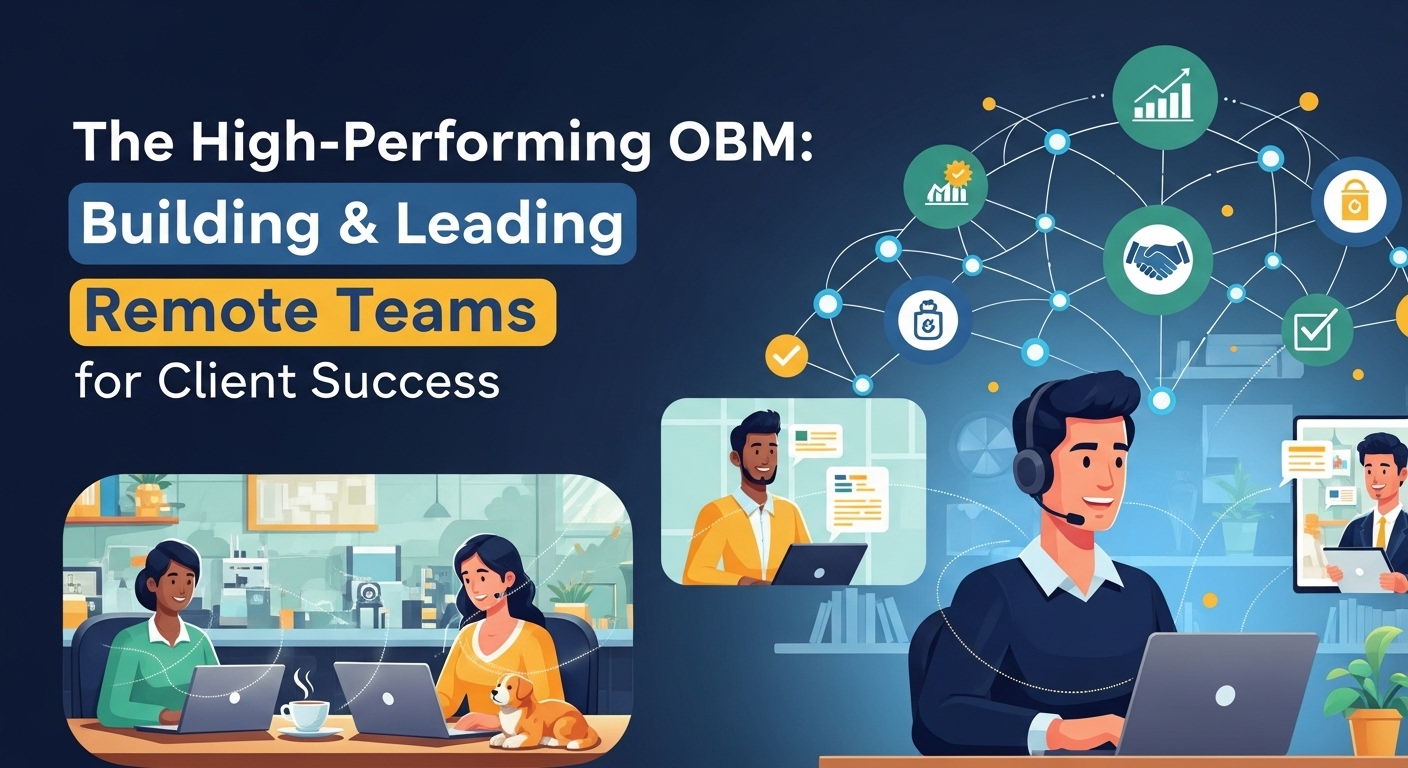The Shift in Modern Business: Why Remote Team Leadership is an OBM’s Superpower
In the ever-evolving landscape of digital business, the role of an Online Business Manager (OBM) has transformed from a valuable asset to an absolute necessity. Visionary entrepreneurs rely on OBMs not just to manage tasks, but to steer the operational ship, implement strategies, and ultimately, drive growth. But there’s a new frontier in online business management that separates the good from the great: the ability to build and lead high-performing remote teams. As businesses increasingly embrace distributed workforces, the OBM who masters remote leadership becomes the linchpin for scalability, efficiency, and unparalleled client success.
Gone are the days of managing a team within the confines of a single office. Today’s teams are global, diverse, and connected by technology. This presents a unique set of challenges and opportunities. How do you foster a cohesive culture when you’re not in the same room? How do you ensure accountability and productivity across different time zones? The answers lie in a strategic, human-centric approach to leadership—a skill set that high-performing OBMs are actively cultivating to deliver exceptional results for their clients.
Understanding the High-Performing OBM’s Role
Before diving into the mechanics of team building, it’s crucial to understand the strategic position a modern OBM occupies. This isn’t about being a glorified virtual assistant; it’s about being a true operational partner to the business owner.
Strategic Partner vs. Task Manager
A Virtual Assistant (VA) is typically a task-doer, executing specific, assigned duties. An OBM, on the other hand, is a strategic thinker responsible for managing the entire operational ecosystem. This includes systems, projects, and, most importantly, the people who execute the work. The OBM looks at the ‘how’ behind the CEO’s ‘what’. They are responsible for ensuring the team has the clarity, resources, and direction needed to achieve the company’s vision. In a remote setting, this responsibility is magnified, as the OBM becomes the central hub of communication and project flow.
The Remote Imperative: Why This Skill Matters Now
The global shift to remote work has solidified the need for specialized leadership. An OBM who can effectively manage a distributed team provides immense value. They free the business owner from the day-to-day personnel management, allowing them to focus on revenue-generating activities and big-picture strategy. Furthermore, a well-led remote team is more engaged, productive, and less prone to turnover, which directly impacts the client’s bottom line and long-term stability. This is the core of modern online business management.
Building Your Remote A-Team: The Foundation of Success
A high-performing team doesn’t just happen; it’s meticulously built. For an OBM, this process starts long before the first team meeting. It begins with a clear strategy for talent acquisition and integration.
Step 1: Defining Roles with Crystal Clarity
Vague job descriptions lead to confusion and misaligned expectations. A top-tier OBM starts by working with the client to create detailed role scorecards. This document goes beyond a simple list of tasks. It should include:
- Key Responsibilities: The primary functions of the role.
- Key Performance Indicators (KPIs): How will success in this role be measured?
- Core Competencies: The skills and traits necessary for success (e.g., proactive communication, tech-savviness, attention to detail).
- Cultural Fit: The values and work ethic that align with the business.
This clarity ensures you attract the right candidates and sets a clear standard for performance from day one.
Step 2: Sourcing and Vetting Top Remote Talent
With a clear role defined, the next step is finding the right person. The beauty of remote work is access to a global talent pool. An OBM should leverage various channels, from niche job boards to professional networks and referrals. The vetting process is critical. It should involve multiple stages, including a portfolio review, a skills-based test or project, and structured interviews designed to assess both technical skills and soft skills like problem-solving and communication.
Step 3: Onboarding for Long-Term Engagement
A new hire’s first few weeks are pivotal. A haphazard onboarding process can lead to disengagement and quick turnover. The OBM must design a structured, welcoming, and informative onboarding experience. This includes:
- A Welcome Packet: With information about the company culture, team members, and key tools.
- A 30-60-90 Day Plan: Outlining clear goals and expectations for the initial months.
- System & Tool Training: Ensuring they are proficient with the company’s tech stack (Asana, Slack, etc.).
- Scheduled Check-ins: Regular meetings with the OBM to answer questions and provide support.
Leading with Purpose: Cultivating a Thriving Remote Culture
Once the team is in place, the OBM’s role shifts to leadership and cultivation. Building a strong remote culture is the secret sauce that keeps a team connected, motivated, and performing at its peak.
Communication: The Lifeblood of a Remote Team
In a remote environment, you must be intentional about communication. Over-communication is better than under-communication. The OBM is responsible for establishing the communication infrastructure and rhythm.
Establishing Communication Channels and Norms
Define which tool is used for what. For example:
- Slack/Teams: For quick daily updates, questions, and team camaraderie.
- Asana/ClickUp: For all project-related communication and task updates.
- Email: For formal, external communication.
- Zoom/Google Meet: For weekly team meetings and one-on-ones.
Setting these norms prevents confusion and ensures information flows efficiently. A weekly team meeting is non-negotiable for alignment, while regular one-on-ones are crucial for individual support and feedback.
Fostering Trust and Psychological Safety
Team members do their best work when they feel trusted and psychologically safe—safe to ask questions, admit mistakes, and propose new ideas without fear of retribution. An OBM builds this by leading with empathy, encouraging open dialogue, and celebrating both wins and ‘learning moments’ from failures. Trust is built through consistency, transparency, and by demonstrating that you have your team’s back.
The OBM’s Essential Tech Stack for Remote Management
Technology is the enabler of effective remote team management. A savvy OBM knows how to select and integrate the right tools to create a seamless virtual workspace.
Project Management Hubs
A central project management tool is the team’s single source of truth. Platforms like Asana, ClickUp, or Trello are essential for assigning tasks, setting deadlines, and tracking progress. The OBM ensures the system is used consistently by everyone.
Communication and Collaboration Platforms
Instant messaging tools like Slack are vital for daily connection, while video conferencing software like Zoom is key for face-to-face interaction. These tools bridge the physical distance and help maintain personal connections.
Documentation and Knowledge Management
How do you ensure everyone knows how things are done? Through robust documentation. Tools like Notion, Confluence, or even a well-organized Google Drive are used to house Standard Operating Procedures (SOPs), training materials, and company information. This is the OBM’s domain—creating and maintaining a central knowledge base that empowers the team to work autonomously.
Connecting Team Performance to Client Success
Ultimately, the success of an OBM is measured by the success of their client’s business. Every team-building and leadership effort must be tied back to tangible results.
Tracking Metrics That Matter
The OBM is responsible for tracking team KPIs and ensuring they align with the client’s business goals. This could include metrics like project completion rates, client satisfaction scores (NPS), or efficiency gains in key processes. By regularly reporting on these metrics, the OBM demonstrates the direct value the team is providing.
A Continuous Feedback Loop
A high-performing team is one that constantly improves. The OBM facilitates this by creating a continuous feedback loop. This involves gathering feedback from the team about processes, soliciting feedback from the client about outcomes, and using that information to iterate and optimize team operations. This proactive approach to improvement is a hallmark of elite-level online business management.
Become the Indispensable OBM Your Clients Need
Building and leading a remote team is no longer a ‘nice-to-have’ skill for an Online Business Manager; it is the core competency that defines the role in the modern business world. By moving beyond task management and embracing the role of a strategic leader, you can create a resilient, productive, and engaged team that becomes your client’s greatest asset. Master the art of remote recruitment, cultivate a culture of trust and clear communication, and leverage the right technology. By doing so, you won’t just be managing a business—you’ll be building its future and solidifying your role as an indispensable partner in its success. Are you ready to elevate your OBM practice and lead teams that deliver extraordinary results?


